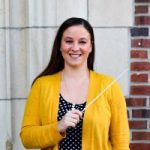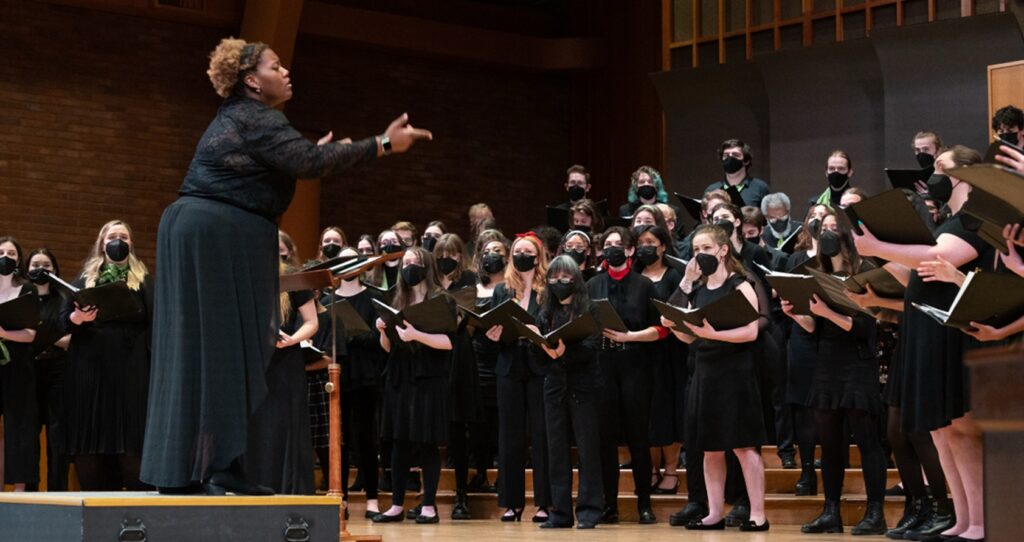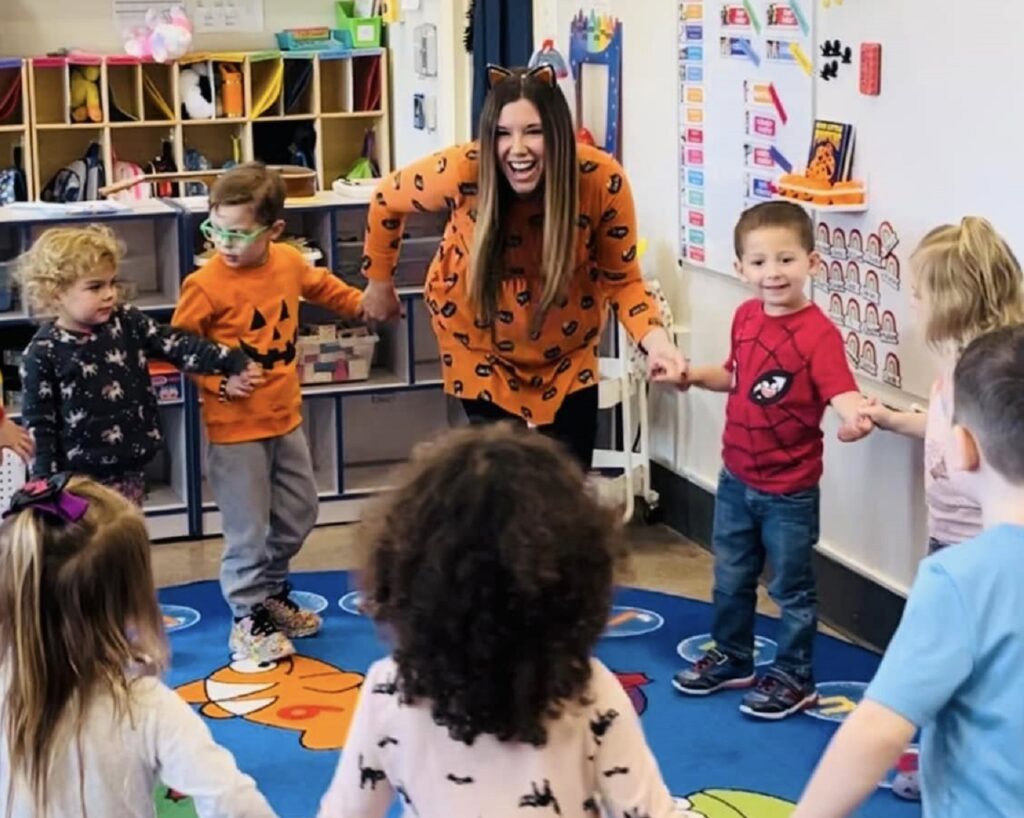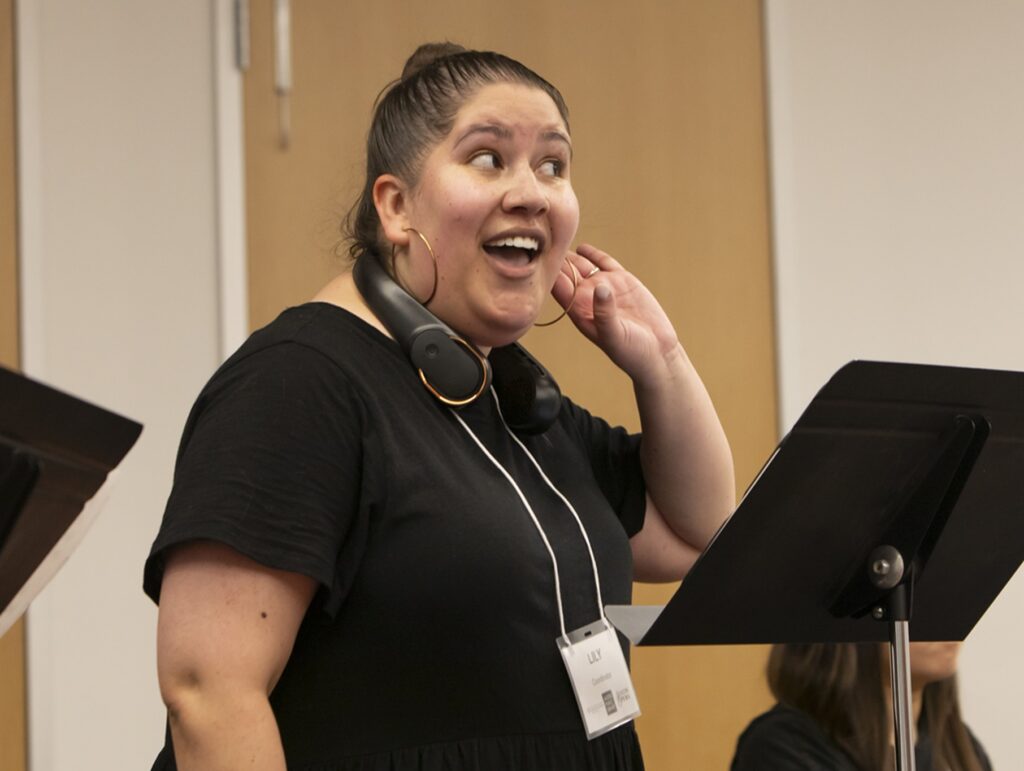Tagged Under:
Case Study: From a $67 Budget to Success — A Four-Year Journey
A middle school band director overcomes challenges — including a paltry budget — to grow her music program.
After two years of teaching elementary general music, I was ready for a change, so I applied to a music education master’s program and for more band jobs.
Luckily, I was hired to teach band at Meadows Elementary and Robinson Middle School in my current district, the Topeka Public Schools. Eager to start my new position, I quickly learned that there were significant challenges and hurdles in my path.
Year 1: Budget and Bellwork
During the first year in my new position, the biggest challenge was little to no budgets in place for my middle and elementary school bands. I also faced additional hindrances including no organizational methods in place, low enrollment numbers, poor instrumentation, students’ lack of musical background knowledge, and a mistrust from administration on the “loyalty” of a traveling teacher. I knew that I had to tackle these issues one by one in order to make progress.
My top priority was budgets. The middle school principal at the time did not understand the cost of band items because the previous director taught band, orchestra and choir, and she spent all her budget on equipment for the musical.
I asked the principal, “What is the budget this year?” Her response was, “I think that $200 for the music department should be good.” My mouth dropped. Split three ways between band, orchestra and choir, that meant my budget for the middle school band was $67 for the whole year. With that paltry budget, I could barely afford to replace the frayed and broken mallets in the old, busted percussion cabinet. I then asked if there was a repair budget and was told that one did not exist. Oh boy.
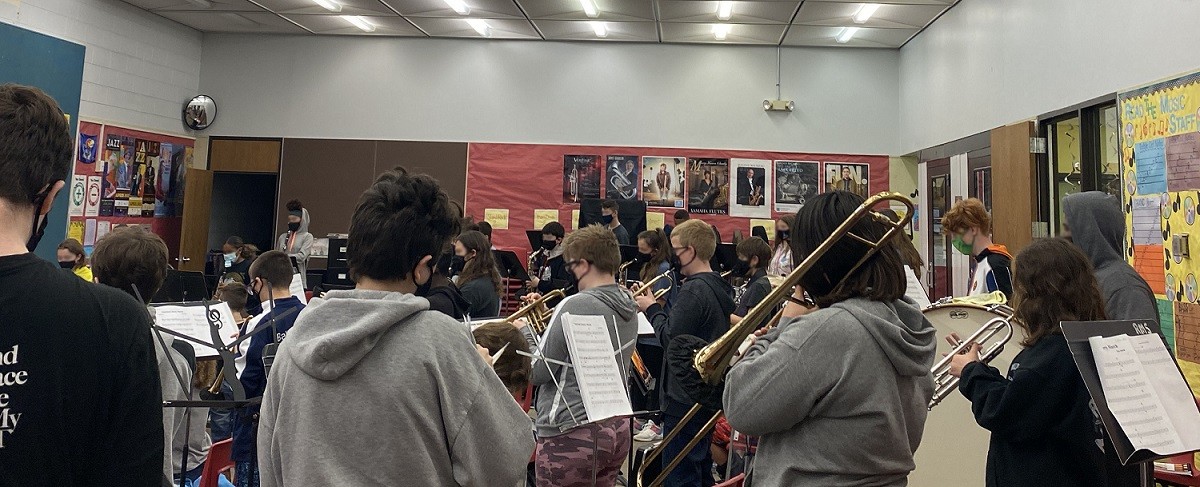 Thankfully, our district had recently made the music librarian the de facto music coordinator for the district, so I went to him and asked for his help and support. Additionally, I came up with several plans of my own. I was not allowed to charge band participation fees, but I could charge instrument rental fees. We have some instruments in the district rental pool, and some instruments at the schools. For the school instruments, I could charge the same rental fees as the district, and I used that money to fund a repair and supply budget. This went into effect almost immediately.
Thankfully, our district had recently made the music librarian the de facto music coordinator for the district, so I went to him and asked for his help and support. Additionally, I came up with several plans of my own. I was not allowed to charge band participation fees, but I could charge instrument rental fees. We have some instruments in the district rental pool, and some instruments at the schools. For the school instruments, I could charge the same rental fees as the district, and I used that money to fund a repair and supply budget. This went into effect almost immediately.
We didn’t have many extra winds instruments for rental, any our percussion equipment was severely lacking. I have since acquired marching bass drums, a vibraphone, chimes, congas, timbales, bongos and various small percussion instruments.
I also did a bit of advocacy and asked the principal to fund some items that our band program needed. I sent her a priority-ranked wish list (which included flutes, trumpets, trombones, chimes, a vibraphone, bongos, cabasa, concert toms, a tambourine, a triangle and beater, marching bass drums and a sousaphone), found some refurbished/used instruments from a local repair shop, and she was able to get some instruments through the general fund.
At the middle school, we could not have specific club/activity fundraisers (only school fundraisers are allowed) so I needed to get creative. Thanks to a band parent, I found a great solution the following year.
For lack of musical literacy, I had an easy solution. Students were required to do some sort of bellwork at the beginning of each class. My initial plan was for students to get their instruments ready, get their music in order according to what was written on the board, sharpen pencils, etc. The principal said that a writing component or thinking question was required because we were working on literacy as a building. So, I revised the bellwork: Students copied down a music vocabulary word and definition from the board into a spiral notebook. Students could use their notebooks to ask questions about music and think about music while using their expanded musical vocabulary.
Then, using the ideas from “Threading the Concept” by Dr. Debra Gordon Hedden, I took the vocabulary word and taught it as a concept in several different parts of the rehearsal including the warmup, listening, rhythmic focus, skills and drills, and the repertoire. I also grouped the vocabulary entries into units that I could pre-test/post-test to check for understanding as well as grade for completion in the notebooks. This procedure of one vocab word per day with an entire lesson focused around that word and organized into units worked remarkably well toward those music literacy goals.
I didn’t want to rock the boat too much that first year. My main focus was adding the vocabulary notebooks and getting the budgets right.
Year 2: Recruitment and Resources
For the following year, I had a longer list of things to focus on: recruiting, communication, budgets (which is always on my list) and instrumentation.
Recruiting: My recruiting efforts began at the end of my first school year. I took my current music students and planned an elementary school tour. We went to five different elementary schools, performed, ate lunch at a park and promoted the summer music program.
When I received my enrollment numbers the following year for the middle school, they went up from 48 to 68 – an increase of more than 40%! However, I still had a very small band class at my elementary school, so I had to rethink how to build my program there.
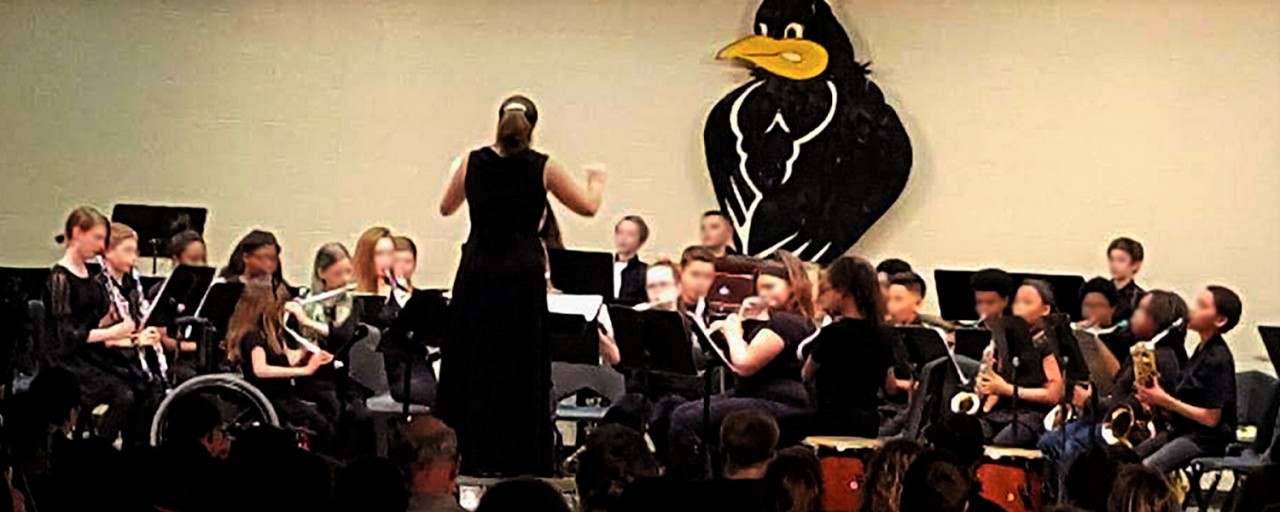 To recruit students for the beginning band at Meadows Elementary, I made sure to talk to all 5th graders on the third day of school along with the elementary strings teacher. She played her instruments, and I played several winds instruments including clarinet, trombone and trumpet. We answered questions and handed out interest forms, which also helped with instrumentation as we could assign students to their first or second instrument choices.
To recruit students for the beginning band at Meadows Elementary, I made sure to talk to all 5th graders on the third day of school along with the elementary strings teacher. She played her instruments, and I played several winds instruments including clarinet, trombone and trumpet. We answered questions and handed out interest forms, which also helped with instrumentation as we could assign students to their first or second instrument choices.
During my second year, elementary band and strings were at the same time as PE and music, which was not ideal. I spoke to the principal, and band and strings were moved to different times, such as during lunch recess and library time, but these times did not work either. Finally, band and strings were scheduled during the independent work block, and this has worked well for me and my students.
Band class at Meadows Elementary is 35 minutes every day. At the beginning of the school year, I see woodwinds on Mondays and Wednesday, brass and percussion on Tuesdays and Thursdays, and everyone on Fridays. Toward the middle of the third quarter, I switch to seeing all students every day to prepare them for middle school, where I see all band students every day for 42 minutes. This schedule has been super helpful in retaining students as I am one of my own feeder schools for Robinson Middle School.
We also started instrument information and placements in the spring with 4th graders. Students filled out forms listing which instrument they liked and which instruments they could play, and then students ranked their top five choices. We kept these records each year and passed them along to other teachers in our district if students moved. By placing students on the right instruments for them and getting the schedule under control, I tripled enrollment at my elementary school — enrollment grew from 12 to 36 — and my middle school numbers grew to 98 students. For the 2020-2021 school year, I was supposed to have 104 students in the middle school band, but unfortunately due to COVID-19, this didn’t happen.
Organization and Communication: For my second year, I wanted to work on organization and communication. Because I had more time to prep, I created a band handbook that I provided to all students. It included a parent signature page and outlined all of my expectations, performance dates, grading policies and everything else that I thought my students and parents needed to know. I also created a Facebook page for my middle school band. The handbook and Facebook helped me start building more relationships with band parents and families who could see exactly what was happening and when in multiple formats. Here is the 2019 RMS Handbook.
Budgets and Fundraising: My budget increased for my second year to $500 for my middle school band alone, which was seven times more than my first year! Then a band parent, who was on the PTO, approached me with some ideas. She said that the PTO would pay for a bus for our tour of elementary schools and other local venues to perform, as well as to travel to contests if we played at the pancake feed. No problem.
She also suggested that we have a bake sale at our concerts. What a great idea! At the first bake sale, we made $50, and I was so excited. Now parents have come to expect a bake sale, so we make over $250 at every concert, and we have four concerts per year. This money has allowed me to purchase equipment for the band, offer instrument rental scholarships, send kids to music camps, purchase supplies for students and more. All of the food is parent-made. I usually bring some baked goods, too, and I talk it up a lot. Kids are excited to buy Mrs. Antonetti’s cookies. We have also added bottled water to our offerings.
Instrumentation: I talk about all of the different types of instruments in my ensembles, and I frequently play different instruments in class. This really grabs the attention of many of my students. I keep saying things like, “If you improve on this instrument, then maybe in January, you can try this other instrument.”
When switching students to different instruments, I try to keep them in the same family. For example, I will find a saxophonist with a big, powerful sound and put him or her on tenor, then eventually bari. Or, I’ll try to find a clarinet student with a big, full sound to play bass clarinet. Or, I’ll take some strong trumpet players and switch them to horn.
I have had a lot of success with switching trumpet players who can only get the first four notes on trumpet to treble clef baritone. I had two students who struggled with trumpet. I switched both to baritone, and they could both instantly (within the same class period of getting the instrument) play the B-flat scale that they had been struggling with all year. I eventually switched one of those students to tuba.
My middle school students come from several different elementary schools with different teachers, so for percussion, we jump into snare, bass and mallets from the beginning. They all rotate instruments between each scale pattern, method book exercise, etc., and I assign them different parts on each of the pieces we do so that no one is funneled into being a certain “type” of a percussionist. This has worked well for my students.
Year 3: Amplify and Expand
By my third year, I had several great things in place. My goal was to continue with what I was doing and amplify, expand and get creative. I was able to reach these goals in several ways:
- Started to streamline my organization and processes for teaching concepts. For example, I worked on folder organization, vocabulary units and physical visual aids to help teach abstract concepts.
- Expanded the use of the vocabulary journal to include gluing in diagrams and answering questions so that it was more like an interactive notebook.
- Included more project-based learning such as a composition project, improvisation and more reflections. In order to introduce composition techniques to young students, I used chance music activities such as this chance composition worksheet with pentatonic scales and dice. These worksheets help bridge the gap of knowledge for students who have never done any composition before. Encouraging creativity and helping students make a plan (even if it was based on chance) motivated them to take positive risks in the classroom.
- Encouraged more students to participate in solo and ensemble festivals, and I helped to revitalize the middle school solo festival at Washburn University.
- Continued the bake sales and kept looking for alternate and creative funding.
- Expanded the repertoire list at my school to include more diverse composers and representative literature from various cultures and backgrounds. I have really tried to include more female composers and LGBTQ+ composers in my literature selection. Some of those have included Julie Giroux, Alex Shapiro, Randall D. Standridge, Anne McGinty, Robert Sheldon and more. I have also included band arrangements of folk music from other countries such as Japan, Ireland, Africa (Swahili), China, Russia, Guatemala, Cuba and more.
Year 4 and Beyond
 With each year of experience, I have gained more confidence as a music educator and have found better ways to be effective, efficient, and to challenge and support my students in the classroom. I have brought in guests from universities and local businesses to talk to my students and broaden their understanding of music. I have commissioned new works for my band as part of a consortium. I have taken my groups to festivals, tours and on trips to enrich their band experience. I just want to continue to challenge my students and let them experience life through the power of music.
With each year of experience, I have gained more confidence as a music educator and have found better ways to be effective, efficient, and to challenge and support my students in the classroom. I have brought in guests from universities and local businesses to talk to my students and broaden their understanding of music. I have commissioned new works for my band as part of a consortium. I have taken my groups to festivals, tours and on trips to enrich their band experience. I just want to continue to challenge my students and let them experience life through the power of music.
For the 2021-2022 school year, I am moving to Topeka High School as the head band director. Some of my goals in this new position is to do more fun things in band since we did not get to have as much fun during the year of COVID. I also want to work on music and rhythmic literacy, and some fundamentals because we missed out on so much instructional time this year. I also want to work on empowering student leadership to have a more active role in coaching younger students. We have a bit of remediation to take care of, but we are going to have fun doing it!









